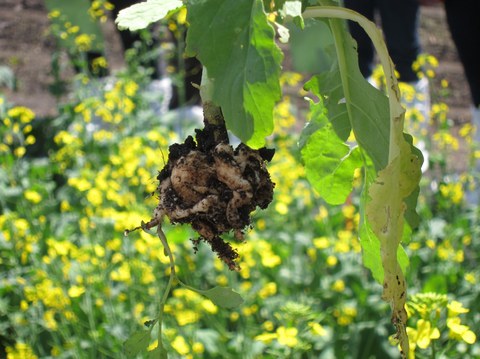Aug 03, 2021
Keeping clubroot in rapeseed in check by using fungi

Clubroot-affected plants have large, tuberous thickening of the roots.
Teams from the Chair of Plant Physiology at Technische Universität Dresden and the Julius Kühn Institute in Braunschweig have been researching biological methods to better control the widespread plant disease 'clubroot' in rapeseed in a joint project. They were able to observe an increase in fresh weight in infected plants through the addition of the fungus 'Acremonium alternatum'. This is a promising first result for the agricultural industry. The final report of the project, which was funded by the Union zur Förderung von Öl- und Proteinpflanzen e.V. (UFOP, “Union for the Promotion of Oil and Protein Plants”), has now been published.
Especially in northern Germany, but also here in Saxony, the golden-yellow rapeseed carpets dominate the landscape in spring. Rapeseed is one of the most important crops in Europe and North America. However, the wide distribution and often close crop rotation favor the spread of plant diseases.
Clubroot is one such typical crop rotation disease that is inexorably on the rise and poses major problems for many agricultural enterprises. The disease is caused by the pathogen Plasmodiophora brassicae, whose permanent spores are characterized by a very long life span of up to 20 years in the soil. The infected plants show large, tuberous thickening of the roots. Due to the low proportion of fine roots and the disturbed conductive pathways, water and nutrient deficiencies arise and the plants develop poorly. High yield losses up to total failure may occur.
The cultivation of resistant varieties often seems to be the last resort. But even this promises only short-term relief. All resistant varieties currently on the market are based on the same resistance gene. This focus on one resistance has already led in the recent past to the formation of mutations that are more aggressive than the original pathogens and increase the risk of resistance breaking. Control mechanisms for clubroot in the field, such as liming the soil or postponing sowing dates, are mostly dependent on the soil and weather situation and therefore not very reliable.
In the project "Biological control of clubroot in resistant and susceptible rapeseed varieties by endophytic fungi" led by Jutta Ludwig-Müller, Professor of Plant Physiology at Technische Universität Dresden, and Dr. Nazanin Zamani-Noor, from the Julius Kühn Institute (JKI) Braunschweig, a novel biocontrol organism was investigated for possible application in the field. The scientists analyzed the potential of the fungus Acremonium alternatum in comparison with a susceptible and a resistant rapeseed variety to keep damage from clubroot in check.
To this end, suitable spore concentrations for treatment were first determined under greenhouse conditions. This was followed by trials in raised beds by inoculating infested plants with Acremonium alternatum. While no strong effects on disease symptoms, i.e. mainly tuber formation, were observed, both rapeseed cultivars showed improved aboveground growth. This could lead to improved yield in the field despite root symptoms.
To make better use of the fungus for applications, the scientists also conducted initial trials to coat the seed with the fungus.
"Our results are very promising, but much more research is needed before the method can reach market maturity," explains Prof. Ludwig-Müller.
Media inquiries:
Prof. Jutta Ludwig-Müller
Chair of Plant Physiology
